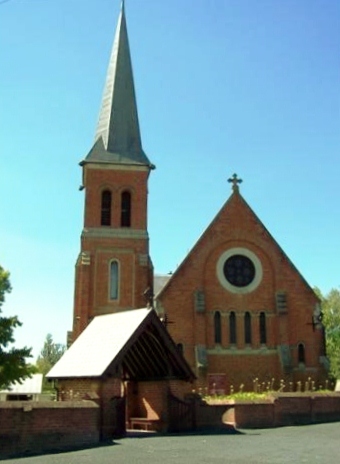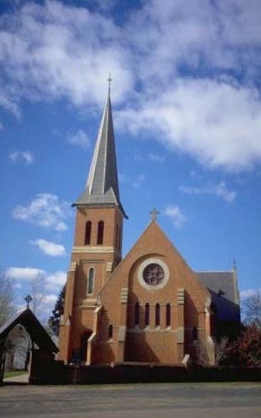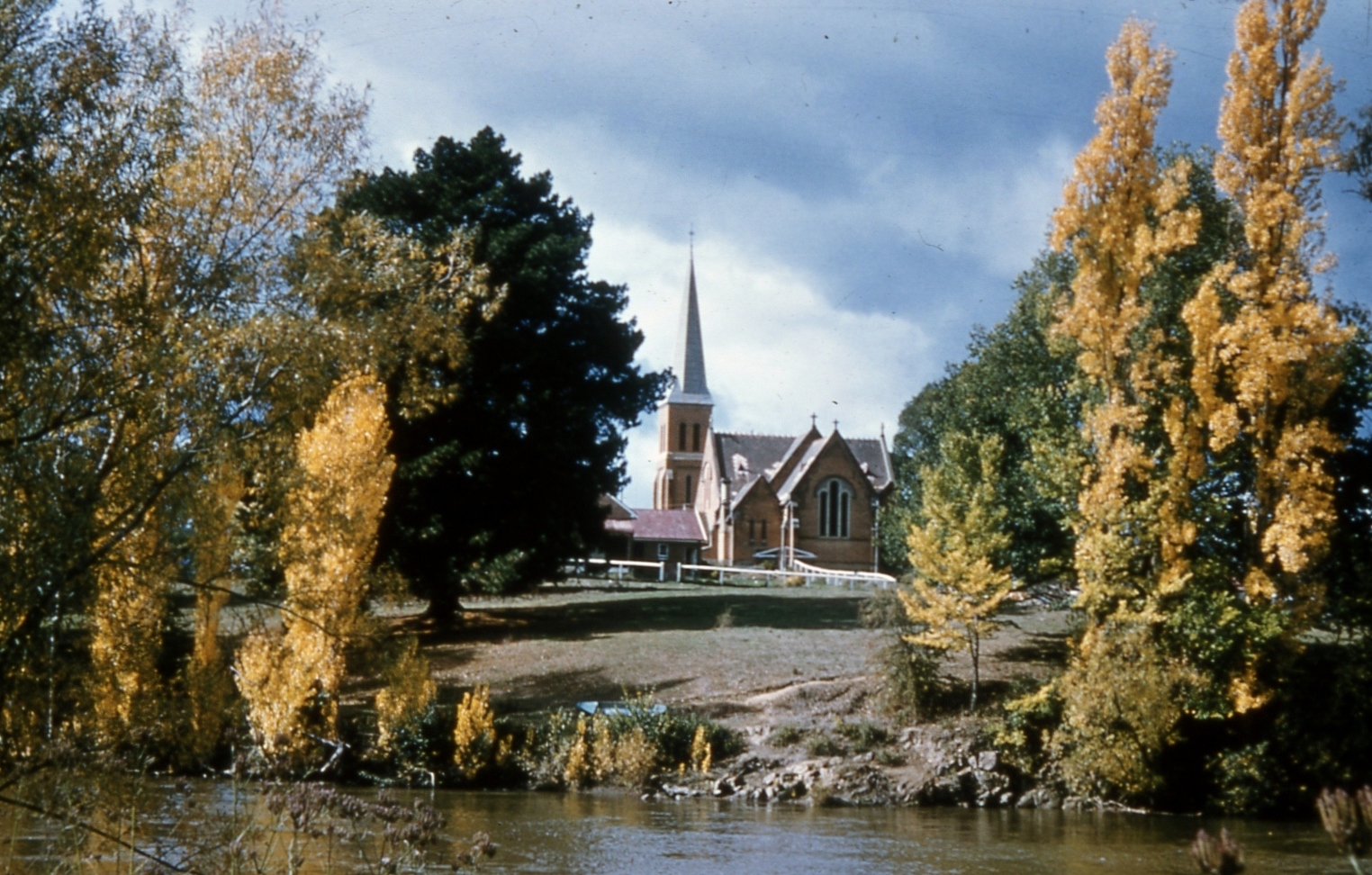
River Street,
Tumut, NSW

Photo of Fox
1855 The Rev. Samuel Fox, was the first resident Anglican clergyman, to come to Tumut. He lived at Bombowlee with the Bridle family for some time.
By horse or horse and carriage the Rev had to cover a large area of the South West Slopes and the Riverina including Wagga Wagga. By todays standards the reverse would happen as Wagga Wagga has gone on and become a city.
CHURCH DESIGN A rough design for a church was drafted by a local citizen, Mr George Shelley, of Tumut Plains.. It was ignored and in 1857, as a temporary measure, an 'Episcopalian barn' was constructed to serve the community.
A proper church was started in 1875 with the laying of a foundation stone. The architect, although he almost certainly never saw the completed building, was Edmund Blacket who was the leading architect of the time designing, amongst other buildings, the Quadrangle at Sydney University.
The nave of the building was completed in 1876, a stone font was designed by Blacket in 1879 and his sons replaced the pews in 1886 and re-roofed the building in 1908. It is regarded as one of Blacket's finest buildings although it is much modified from the original plans. It is also a rare example of a Blacket building constructed out of bricks. Most of his buildings were constructed of stone.
It is a Gothic Revival-style church and is designed in a cruciform pattern with two vestries and a square buttressed tower and broach spire.
Story 2
All Saints' Anglican Church - Tumut - 1926 T.C. Edwards. Reb. 1963 S.T. Noad & Son. 2m., 13 sp.st., 6c., el.pn.
The foundation stone of the present All Saints' Church was laid in December 1875 and the building opened in 1878, the tower and spire being completed in 1882, the latter donated by Mr C.D. Bardwell. The building is an outstanding example of the work of Edmund Blacket in the Norman style constructed in red brick with cement dressings.
In 1990 the building was fully restored. The roof was recovered in Welsh slates (replacing earlier asbestos tiles which had in turn replaced the original wooden shingles) while steel plates were used to reinforce the roof trusses. Replacement wooden gargoyles were carved and placed at the base of the spire.
The interior was repainted in heritage colours. The church incorporates an excellent range of high-quality stained glass, including the east window, a magnificent example of the work of John Hardman & Sons and at the west end a fine rose window depicting the four evangelists. The carved pews appear to have been designed by the architect.
Sited in an open position in the north transept, the organ was built by the Sydney organ builder T.C. Edwards in 1926 at a cost of £1,250, utilising English pipework from Alfred Palmer & Sons.
Originally with two manuals, 11 speaking stops and tubular-pneumatic action, it was rebuilt with electro-pneumatic action in 1963 by S.T. Noad & Son. In 1990 Peter D.G. Jewkes restored the chests, action and bellows and a few years later upgraded the action with solid state circuitry from SSL and fitted new keyboards, also inserting a Fifteenth 2ft on a spare slide on the swell windchest. It is a fine example of contemporary organbuilding with an outstanding and robust sound.© PdL 2006
1878 - On Friday evening last the members of the Building Committee of All Saints' Anglican Church met at the vicarago, when tenders for the proposed extension of the church were opened. The committee resolved to erect the walls of the transepts and chancel, as they had sufficient funds in hand to complete this work, and by the time of its completion they anticipated they would be in a polution to call for tenders for the roof. The tender of tho Messrs. Kinred, Brothers, of Adelong, was then accepted for the foundations and brickwork.
1878 - The chairman informed the committee that the residents of Blowering contemplated building a small neat church upon a site which had been granted there for tho purpose. It was thereupon resolved to aid'the Blowering people in their object by presenting them with sorao of the windows formerly used in the Tumut church, which had been taken down to ma ko room for the present structure.- (Ref- The Sydney Morning Herald (NSW : 1842 - 1954)(about) Previous issue Monday 25 February 1878).
GREAT Open Diapason Stopped Diapason Dolce Principal Harmonic Flute Swell to Great
SWELL Open Diapason Rohr Flute Salicional Voix Celeste Gemshorn Fifteenth Sub Octave Unison Off Octave
PEDAL Bourdon Principal Flute Great to Pedal Swell to Pedal 8 8 8 4 4 8 8 8 8 4 2 16 8 8 A TC B A B
Electro-pneumatic action Detached stopkey console
Welcome to All Saints' Anglican Church, Tumut Graeme D. Rushworth, Historic Pipe Organs of New South Wales, Sydney: Hale & Iremonger, 1988, p.174. Specification and further historical information supplied by Peter Jewkes August 2003

C/E Church Front view
1875 - All Saints Anglican Church was built in 1875 in River Road, Tumut. Like all churches in Tumut it has witnessed hundreds of births, marriages and deaths celebrations. There is a wonderful archive record filed for reference.

C/E Church from Tumut River
1934 - DR. BURGMANN AT TUMUT. - TUMUT, Monday. - The Right Rev. Dr. Burgmann, Anglican Bishop of Goulburn, and Mrs. Burgmann, have just completed a five-days' visit to Tumut. Dr. Burgmann was tendered a civic reception. Services were held at Tumut, Gilmore, Blowering, and Toomooroma, and nearly 100 candidates were confirmed at the various centres. The Bishop spoke at the flag ceremony in Tumut Intermediate High School, and conducted a children's service at church. Dr. Burgmann's visit was a fitting termination to "All Saints' " Church golden jubilee celebrations. - (Ref- The Sydney Morning Herald (NSW : 1842 - 1954)(about) Previous issue Tuesday 13 November 1934).
The members of All Saints (Anglican) Church purpose presenting their vicar, the Rev D. Jones, with a testimonial and address prior to his leaving Tumut for Deniliquin is set for the close of the year. On Monday evening last a meeting of the parishioners was held at the church to make the necessary arrangements.
1876 - Mr. I. A. Newman occupied the chair several speakers testified to the high respect and esteem which their clergyman is held by all classes of the community. and naturally adverted to the genernl regret felt at his removal; but it was pointed out that the Rev. gentleman's failing health had long bean a matter of deep anxiety to his friends, and, contrary to their wishes and advice, when a more eminent position was offered for his acceptance, their beloved vicar had at considerable self-sacrifice chosen to remain amongst them. It was now imperative that he should seek a change of climate. and in doing so the Bishop of the diocese, in recognition of the Rev. D. E. Jones's zeal and ability, had elevated him to the dignity of an archdeacon. - (Ref- The Sydney Morning Herald (NSW : 1842-1954) Saturday 9 December 1876).
In the 1950's a hall was built across the road, it also has been the venue for many wonderful gatherings.